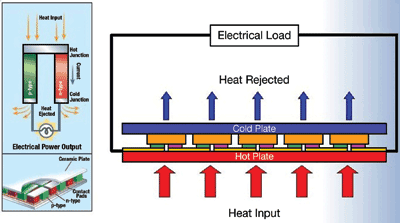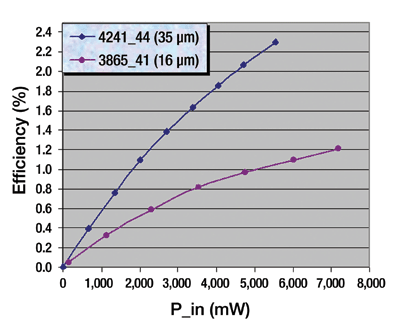Energy harvesting with thin-film thermoelectrics
Today’s efficiency and reduced parasitic loss of thin-film thermoelectrics make it attractive for energy harvesting
BY PAUL A. MAGILL
Nextreme Thermal Solutions
Durham, NC
http://www.nextreme.com
The efficiency of power generation is increasingly important across all market segments. As energy costs continue to skyrocket, system efficiency is becoming an increasingly important attribute. Extracting waste heat from a system and converting some percentage of that heat into usable energy is one way in which system efficiency can be improved.
Energy harvesting, or energy scavenging, is the process whereby a portion of energy is removed, captured and stored from an existing source of unused but available energy. The use of thermoelectrics, in which a temperature difference creates an electric potential, can convert waste heat from thermal sources into usable electricity.
For example, the heat from an exhaust stack at a manufacturing facility can provide power for devices such as wireless sensors used for chemical analysis of the smoke stack effluent. Heat produced during combustion in an automobile engine can be harvested to charge the battery. Harvesting thermal energy can improve the overall efficiency of existing combustion-based devices such as gasoline-powered automobiles or, in the future, hydrogen-burning fuel cells.
Understanding TEGs
Thermoelectric generators (TEGs) are solid-state devices that convert thermal energy into electrical energy through a phenomenon known as the Seebeck Effect. This effect is applied in thermocouples for temperature measurement where a temperature differential generates a measurable voltage. A more advanced application, and one which demonstrates the reliability of thermoelectrics technology, was the powering of the multi-decade Voyager spacecraft mission, which used a nuclear heat source.
A thermoelectric device is made from arrays of couples that consist of a positive leg (p-type) and negative leg (n-type) as shown in Fig. 1 . If heat is flowing between the top and bottom of the TE device (forming a temperature gradient) a voltage will be produced and hence an electric current will flow (see Fig. 1). A thermoelectric module consists of a number of TE couples connected thermally in parallel and electrically in series.

Fig. 1. Thermal-to-electric conversion with thermoelectrics.
Approximately 10 years ago, a new method of fabricating thermoelectric devices using epitaxially grown thin-films was developed by RTI International and later commercialized by Nextreme Thermal Solutions. These thin films demonstrated a high figure of merit, or ZT, making them a competitive alternative to traditional thick pellets used for the previous 40 years.
Cost of power
One important factor in all power generation devices is the cost of the power. This is often reduced to a “dollar per watt” metric. Thermoelectrics have traditionally faired poorly in this analysis largely due to the labor-intensive methods used to manufacture them. These methods involve placing arrays of P- and N-type elements into jigs and soldering them to ceramic plates (called headers). Costs have been mitigated to some extent by outsourcing the assembly operation to low-cost labor markets like China. But the costs need to be significantly lower to become attractive for consumer applications.
Advances in thin-film TEG technology offer scalable semiconductor processes that can be leveraged for considerable cost reduction in high volume. This is accomplished by employing semiconductor packaging methods that allow for large quantities of components to be manufactured in parallel, thereby reducing the per unit cost. As with any semiconductor-like manufacturing process, cost is extremely sensitive to volume since the capitalization costs of the manufacturing facilities are high.
Power conversion efficiency
Another key factor to the cost curve is the efficiency of the device. The principle performance metric for thermoelectrics used for power generation is their power conversion efficiency. In other words, how much of the heat flowing through the TEG is converted into usable electricity. Figure 2 expresses the output efficiency as a function of key thermoelectric module parameters.

Fig. 2. Output efficiency equation.
Several key parameters in Fig. 2 are material properties, namely the Seebeck coefficient, the thermal conductivity and the electrical resistivity. Efforts to optimize thin film thermoelectric properties have succeeded to reduce the thermal conductivity, k, to improve performance. Note that because efficiency is inversely proportional to the square of thermal conductivity, a small reduction in k can have a significant impact on the efficiency of the device.
The Seebeck Coefficient, α, is also an important material property. Unfortunately, as with most material systems, changing fundamental material properties is a costly and time consuming endeavor.
Several other characteristics of the module described in Fig. 2 can be used to address the efficiency of power conversion. The number of PN couples, N, and the active area, A, can both be reduced but doing so can have detrimental effects on other aspects of performance and as such, these changes are usually avoided. Increasing the input heat, Q, is not a device attribute and is dictated by the end application.
The best candidate for efficiency improvement is increasing the thickness, L, of the thermoelectric film. In recent experiments, bismuth telluride epitaxial films have been synthesized, demonstrating a thermal-to-electrical power conversion efficiency increase of more than two-times when compared with baseline thin-film thermoelectric devices operating under the same heat input conditions. At 9 W of heat input power, the devices produced in this program generated 247 mW of output power, equivalent to 2.6% power-conversion efficiency as depicted in Fig. 3 .

Fig. 3. Comparison of conversion efficiency of a standard module to an experimental module.
Placement of TEG devices
Placement of the power generator within the system is another important factor. For a number of complex thermal management reasons, it is better to extract heat for power generation purposes at the system level where there is more thermal headroom than at the die level.
Efficiency is directly proportional to the temperature difference (ΔT) across the module and the power output is proportional to the square of the temperature difference or efficiency. To achieve the highest operating efficiency possible, the module and packaging should be designed to maximize the temperature across the module. Accordingly, an important design goal is the reduction of thermal parasitics from packaging that decrease the ΔT, both inside and outside the device.
To make practical, rugged, field-deployable thermoelectric modules, without compromising performance and efficiency, the packaging and thermal interface materials used must be carefully considered. The thermal performance of the interfaces must be optimized to maximize the amount of heat going through the active thermoelectric material, and minimizing the amount of heat that is diverted through the passive packaging materials. In this way, reductions in ΔT, and in turn, power output and efficiency, can be mitigated.
Target applications
The concept of generating clean power from waste heat is alluring and gaining significant attention worldwide. However there is a direct link between thermoelectric module performance, in terms of efficiency, and the applicability of thermoelectrics in key power generation markets.
The applications that stand out, both in terms of feasibility and market size, are micro power (for example, powering remote sensors or other portable applications) and automobile waste heat energy conversion. While significant technical improvements in thermoelectric devices and systems are required before insertion in the automobile is feasible, remote power is immediately feasible with current technology.
Furthermore, the market for remote power is undeniably large. Sensors alone represent a TAM (total available market) of 8 billion units by 2012 (Semico, 2008); while only a portion of this market will benefit from remote power, a reasonable estimate puts the ultimate potential at over 100-M units per year for this application.
By increasing the efficiency of the thin-film power generators, combined with continued reduction in parasitic electrical losses, thin film thermoelectric technology becomes an extremely attractive option for energy harvesting as an alternative energy source. ■
For more on energy harvesting, visit http://www2.electronicproducts.com/Power.aspx.
Advertisement
Learn more about Nextreme





